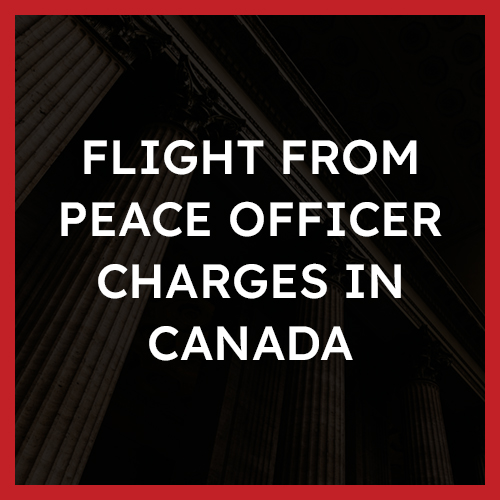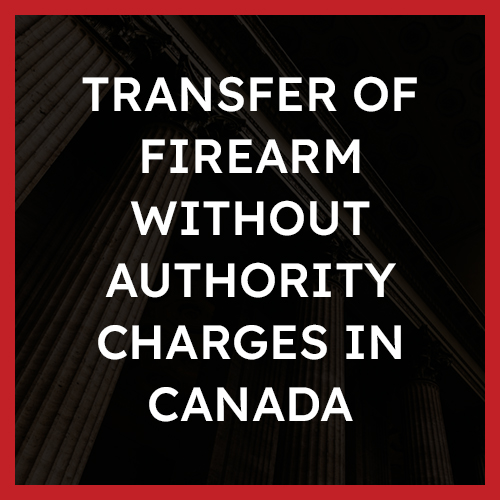Flight from Peace Officer Laws in Canada Explained

Flight from a peace officer is a dual/hybrid offence, which means that the crown prosecutor may proceed by indictment or summarily. If convicted, and the crown proceeds by indictment, the maximum punishment is 10 years imprisonment.
Examples
An example of a charge of Flight from peace officer may include the following:
- A person is speeding, and has warrants for their arrest and sees a peace officer activate lights and sirens on an emergency vehicle. The person chooses to drive away and not stop for the police officer.
- A person is driving a stolen vehicle, and upon seeing a peace officer activate lights and sirens positioned behind them, drives erratically and speeds through other motorists in an attempt to evade the peace officer.
- The driver of a vehicle has just committed a crime, and upon seeing a peace officer attempt to stop them, speeds away in order to flee.
Defences
The defences available to a charge of Flight from peace officer are entirely dependent on the facts of your case.
However, some defences to a charge of Flight from peace officer may include:
- The accused did not have a safe place to pull their vehicle over. Perhaps the peace officer sought to pull them over on a high speed roadway without a parking lane.
- The accused was not in a motor vehicle or vessel. For example, riding a bicycle.
- The accused was not aware that the peace officer was trying to stop them and did not intend to evade
Punishment
A charge of Flight from peace officer is a hybrid/dual offence, which entails a maximum punishment of 10 years imprisonment if the crown proceeds by indictable offence and if convicted.
Overview of the Offence
According to s. 320.17 of the Criminal Code:
Flight from peace officer
320.17 Everyone commits an offence who operates a motor vehicle or vessel while being pursued by a peace officer and who fails, without reasonable excuse, to stop the motor vehicle or vessel as soon as is reasonable in the circumstances.
The Guilty Act (Actus Reus)
The actus reus for a charge of Flight from a peace officer under s. 320.17 is established by proof, beyond a reasonable doubt, of the following:
- The accused was operating a conveyance, and failed to stop, without reasonable excuse, for a peace officer in the lawful execution of their duties
The Guilty Mind (Mens Rea)
The mens rea for a charge of Flight from a peace officer under s. 320.17 includes proving, beyond a reasonable doubt, that:
- The accused had knowledge that they were required to stop for the peace officer in the lawful execution of their duties
Defences
How to Beat a Charge of Flight from a peace officer
Every case is different. The availability and strength of any defence depend entirely on the specific facts of your case. The strength of any available defence rests on the evidence against you and the precise details of the allegations. However, the following are some common defences that may be used when fighting a charge of Flight from peace officer:
Factual innocence
A strong defence against a flight from a peace officer charge is to maintain that you are factually innocent. If you can show that the facts and the evidence do not support the charge.
Lack of Intent/Mistake
If you can show that you were never seeking to commit the offence of Flight from a peace officer, this may be a defence. For you to be convicted of flight from a peace officer, the crown must prove the elements of the offence beyond a reasonable doubt
Identity
Depending on the circumstances of your case, a possible defence to flight from a peace officer may be to raise an identity defence. In this case, for this defence to be raised successfully, you will have to prove that you were not the person who committed the prohibited acts. Perhaps police will be unable to You may have to provide evidence that you were not in fact the (or a) person who committed the offence of flight from a peace officer.
Any applicable Charter defences
The Charter sets out your rights and freedoms before and after your arrest. If the police fail to abide by these rights deliberately or inadvertently, it could aid in your defence. If any of your Charter rights have been violated before or after your arrest, you may be able to have some or all of the evidence that the Crown is relying on to secure a conviction excluded under s. 24(2) of the Charter..
Punishments
The Criminal Code provides for a possible maximum term of imprisonment of no more than 10 years imprisonment.
Frequently Asked Questions
What does Flight from a peace officer mean?
Flight from peace officer under section 320.17 of the Criminal Code of Canada pertains to the operation of a conveyance, such as a motor vehicle, and failing to stop for a peace officer without lawful excuse in the execution of their duties.
Is Flight from peace officer an indictable offence?
Flight from peace officer is a dual/hybrid offence. Therefore, the crown may proceed by either indictment, or summarily.
Can you go to jail for Flight from peace officer?
If you are convicted of flight from peace officer, the maximum punishment is 10 years imprisonment if the crown proceeds by indictment. Therefore, there is a possibility that you can go to jail if convicted.
Published Decisions
R v. Zaworski
The accused pled guilty to numerous charges, including flight from police. The accused stole a Ford F350, and as police sought to conduct a traffic stop on the accused, activating emergency lights and sirens, the accused proceeded to engage in a high risk flight from police, which included fleeing from the vehicle into a private residence afterward.
You can read the full article here.
R v. Smith
The accused was convicted of flight from police, however his sentenced was reduced due to the disproportionate amount of force used by the police in the city of Lethbridge. A police officer discharged their firearm as the accused passed by the police officer and police vehicle, apparently trying to shoot at the tires in hopes of disabling the vehicle. As a result of this, the judge reduced the sentence imposed.
You can read the full article here.
R c. Martin
The accused was convicted of flight from police after police pursued the accused, driving a yellow Mustang, throughout the city of Montreal. The pursuit lasted approximately 8 minutes, and ended only when the accused collided with another vehicle on the roadway.
You can read the full article here.
Contact Us
If you have been charged with a criminal offence, visit our location pages to contact our team.
About The Author







